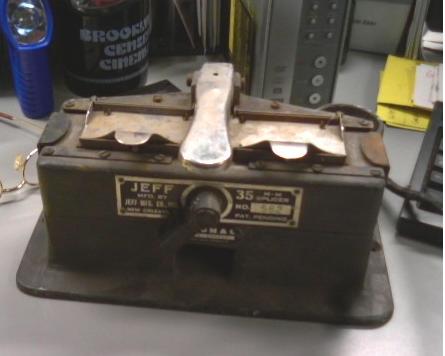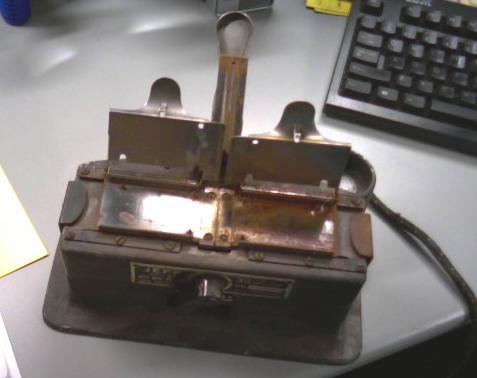|
|
 
|
|
Author
|
Topic: What kind of splicer is this?
|
Frank Angel
Film God

Posts: 5305
From: Brooklyn NY USA
Registered: Dec 1999
|
 posted 11-11-2008 09:57 PM
posted 11-11-2008 09:57 PM





I came across this splicer. The plate on it says "Jeff Mfg. Co. Inc. 35mm Splicer. A second plate says National Theatre Supply. The handle is marked "Open Close" It didn't seem to do anything at first but after a good soaking in Liquid Wrench Silicone Spray, the two plates do move apart to reveal nothing but a hollow area beneath. The hinged handle in the center has no cutter on it but a flat plate about the thickness of an Academy 1.37 frameline. The pressing down on the handle makes that piece extend down on the film, but again, it cuts nothing.
At first the electrical cord make me thing it might be an ultrasonic splicer, but no, there what looks like just a light inside that I assume lights up the area under the film. But how one is supposed to cut the film or use cement on it is not apparant, at least not to me. I would imagine this was a cement splicer of some sort because that well looks suspiciously similar to the size bottles that acetone cement came in.
If anyone knows how this thing works, I'd be interested. It looks to me, although I have yet to check it throughly, but it looks like the sprockets are fox sprocket size. Take a look (it's only a cell phone cam so sorry for the quality)

This next is with the two film hold down clamps opened as well as the spring loaded middle handle thing raised. This piece presses down on the film which is held down by the side clamps but it is not designed as a cutter. Although you can't see it very clearly, there is a flat metal piece that protrudes out of the larger block. When you press the top handle down, the smaller center piece (the size of a frameline) will extend out of it's center, but there is no blade on it nor does it look like there is any way that it was designed to carry a blade.

This is from the rear. There is a switch, but all it does is turn on a light under the film. And possibly heat up the underplate? I have to dismantle the whole thing to see -- it looks like there is a heat element in there as well. I haven't pluged it in yet until I can double check the condition of the wire.

| IP: Logged
|
|
|
|
|
|
|
|
|
|
|
|
|
|
|
|
Stephen Furley
Film God

Posts: 3059
From: Coulsdon, Croydon, England
Registered: May 2002
|
 posted 11-12-2008 12:07 PM
posted 11-12-2008 12:07 PM




When I visited the National Film and Television Archive there were various type of splicers around, but none of them was being used; all splicing was being done by hand. The reason they gave for this was that much of the film they work with has too much shrinkage to correctly fit the pins on a standard splicer. The emulsion was scraped by eye with a razor blade, the film was cleaned, placed emulsion up on the glass and held in place by a small weight. The other end was then cleaned, aligned with the first one by eye, and held in place by a second weight. I'm not sure if the alignment of the edges was checked with a straight-edge, but the perforations were certainly aligned by eye. The end of the top strip was lifted far enough for the cement, which they mixed themselves, to be applied with a brush, and then the other end lowered onto it. I think a third weight must have been used to press the ends together for a few seconds. The cement dried very quickly, even quicker than the stuff which Kodak used to sell in a metal can, which was the best cement I ever found. This was all nitrate of course; always the easiest base to cement splice. Diacetate was terrible; I had some cement which was supposed to have been designed for it, but it was very difficult to get a good splice. Triacetate isn't bad, but it's not as good as nitrate.
| IP: Logged
|
|
|
|
|
|
All times are Central (GMT -6:00)
|
|
Powered by Infopop Corporation
UBB.classicTM
6.3.1.2
The Film-Tech Forums are designed for various members related to the cinema industry to express their opinions, viewpoints and testimonials on various products, services and events based upon speculation, personal knowledge and factual information through use, therefore all views represented here allow no liability upon the publishers of this web site and the owners of said views assume no liability for any ill will resulting from these postings. The posts made here are for educational as well as entertainment purposes and as such anyone viewing this portion of the website must accept these views as statements of the author of that opinion
and agrees to release the authors from any and all liability.
|

 Home
Home
 Products
Products
 Store
Store
 Forum
Forum
 Warehouse
Warehouse
 Contact Us
Contact Us




 Printer-friendly view of this topic
Printer-friendly view of this topic














![[Eek!]](eek.gif) Egads!
Egads! ![[Big Grin]](biggrin.gif)



